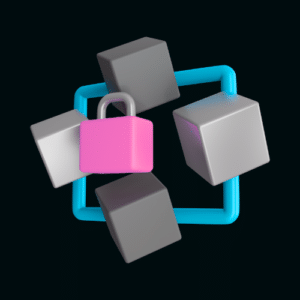What is a Blockchain?
Content of this post:
- What is Blockchain
- What is DLT (Distributed Ledger Technology)
- Decentralization
- Types of Blockchain
What is a Blockchain?
The blockchain is a type of shared database (Distributed Ledger Technology – DLT) that differs from a typical database in the way it stores information; blockchains store data in blocks linked together via cryptography.
In a blockchain, transactions are stored within blocks and each newly generated block contains a reference to the previous one: an identifying number called a “hash“. These blocks form a chain, hence the name “blockchain.”
In blockchains like Bitcoin, trust is based on the fact that blocks are visible to everyone, and no transaction is added to a block without first being verified by a miner.
This way, the community ensures that no fraudulent transaction is recorded.
As a result, a blockchain can also be used by parties that don’t trust each other, as they know their transactions cannot be compromised.

What is DLT (Distributed Ledger Technology)?
Distributed Ledger Technology is a digital system that lets users and systems record transactions related to one or more assets. A distributed ledger technology stores the information at multiple locations, at any given point of time.
DLT, unlike traditional databases, does not have any central place to store information.
It’s worth mentioning that the idea of a distributed ledger has been around for quite some time. For years, companies have gathered and stored data in multiple locations, either on paper or in separate software systems, and only periodically bring the data together in a centralized database.
A company, for example, might have different types of data held by each of its divisions, with each division contributing that data to a centralized ledger only when necessary. Likewise, when multiple organizations work together, they usually hold their own data and contribute it only to a central ledger, controlled by an authorized party when requested or required.
DLT’s major improvement is the ability to minimize or eliminate the time-consuming and error-prone processes necessary to reconcile the different contributions to the ledger, as well as ensuring everyone has access to the current version and its accuracy.

Decentralization
Instead of a central entity like a bank, the entire blockchain network agrees on a shared reality, namely the complete history of every transaction within the network. This agreement is termed “consensus“.
The revolutionary aspect is that processes are not carried out by a single computer but by many computers simultaneously.

Bitcoin is a typical application of this. Trust in Bitcoin is ensured through a decentralized and immutable ledger. Such ledger is not managed by a single company or government, as mentioned earlier, but by an independent community of computers worldwide.
All computers are on the same network, called a peer-to-peer network.
Hence, the model is often called a “distributed trust model“.
Types of Blockchain: Public, Private, Hybrid, and Consortium
So far, we have always referred to public Blockchains like Bitcoin, but in reality there are three other different types. These are: Private Blockchain, Hybrid Blockchain, and Blockchain Consortia or Federated Blockchains.
Fundamentally, these four types of Blockchains are not in conflict… they are indeed different applicative models of this disruptive technology:
- Public chains tend to excel in terms of censorship resistance but lack in terms of speed and performance. Their transaction ledger is visible to anyone and ensures transaction security and data immutability.
- Private chain, unlike public ones, can prioritize system speed as it doesn’t have to worry about central error points like public Blockchains. These are ideally employed in situations where an individual or organization needs to remain in control while having information kept private. They still lack censorship resistance, thus they are used in business or institutional contexts. Generally, they have a smaller size compared to public chains.
- Hybrid chains retain both public and private elements within them. Anyone can have partial access to the network, but only an entity or a small group of individuals have unlimited access. Regarding the visibility of the transaction ledger, it is typically not public: users need authorization to access the Blockchain. The potential applications of a Hybrid Blockchain are many.
For instance, companies use it for retail sales so that only some information is shown to the public. Hybrid Blockchains could potentially find many applications in the institutional sector: the healthcare sector in particular can use them to make individual users able to visualize personal information from medical records via a smart contract, making their content immutable. - Blockchain Consortium or federated chains, which contain both public and private elements, mitigate some of the risks associated with counterparties by removing centralized control. A lower node count typically allows them to have much more efficient performance than public chains. Network control lies in the hands of the consortium, as their name suggests. These chains are likely to be used to streamline communication among consortium members.
Follow AudaSynth on Twitter and Telegram to stay updated!
Twitter/X: https://twitter.com/AudaSynth
Telegram Channel: https://t.me/audasynth_ann

